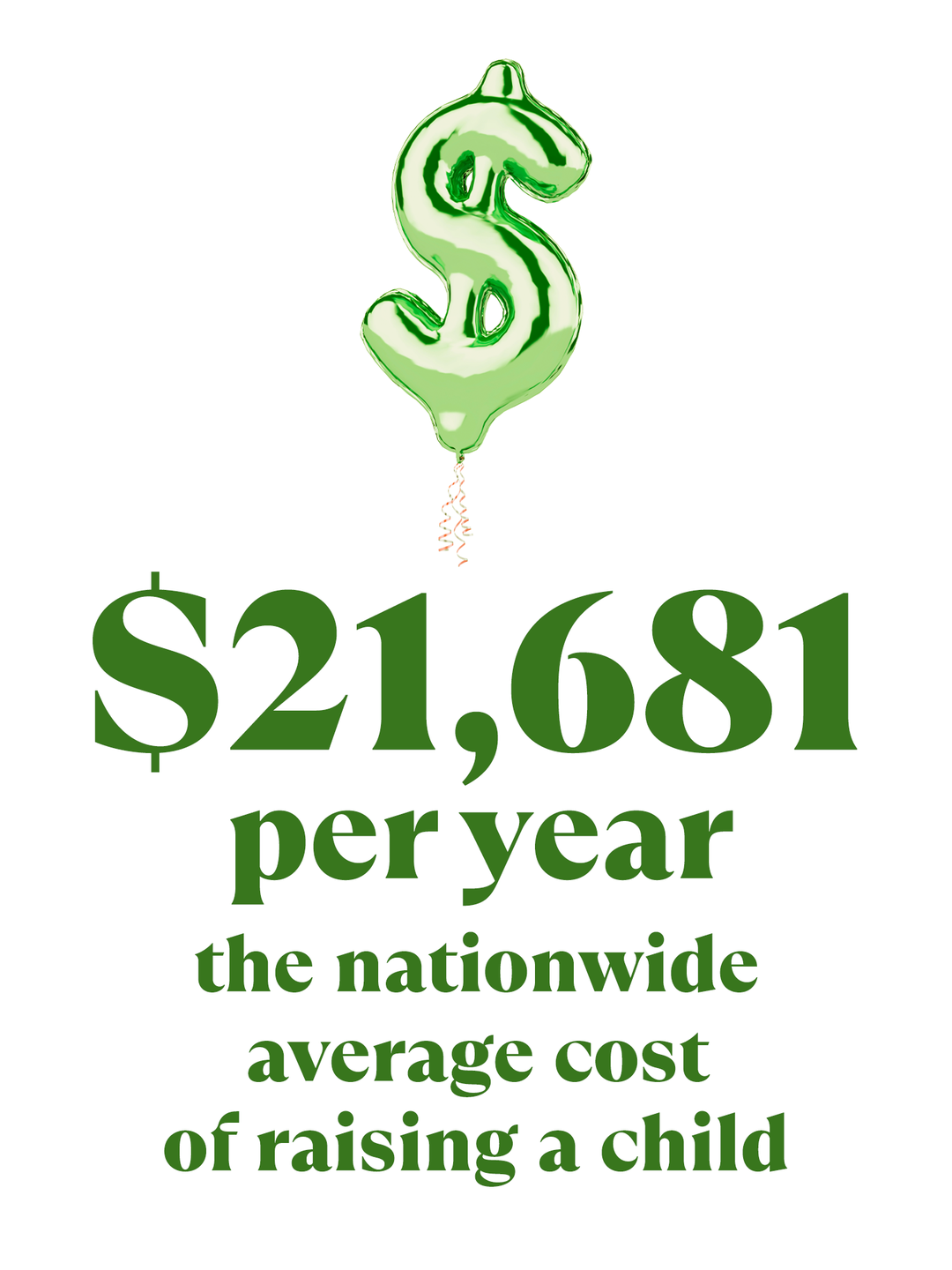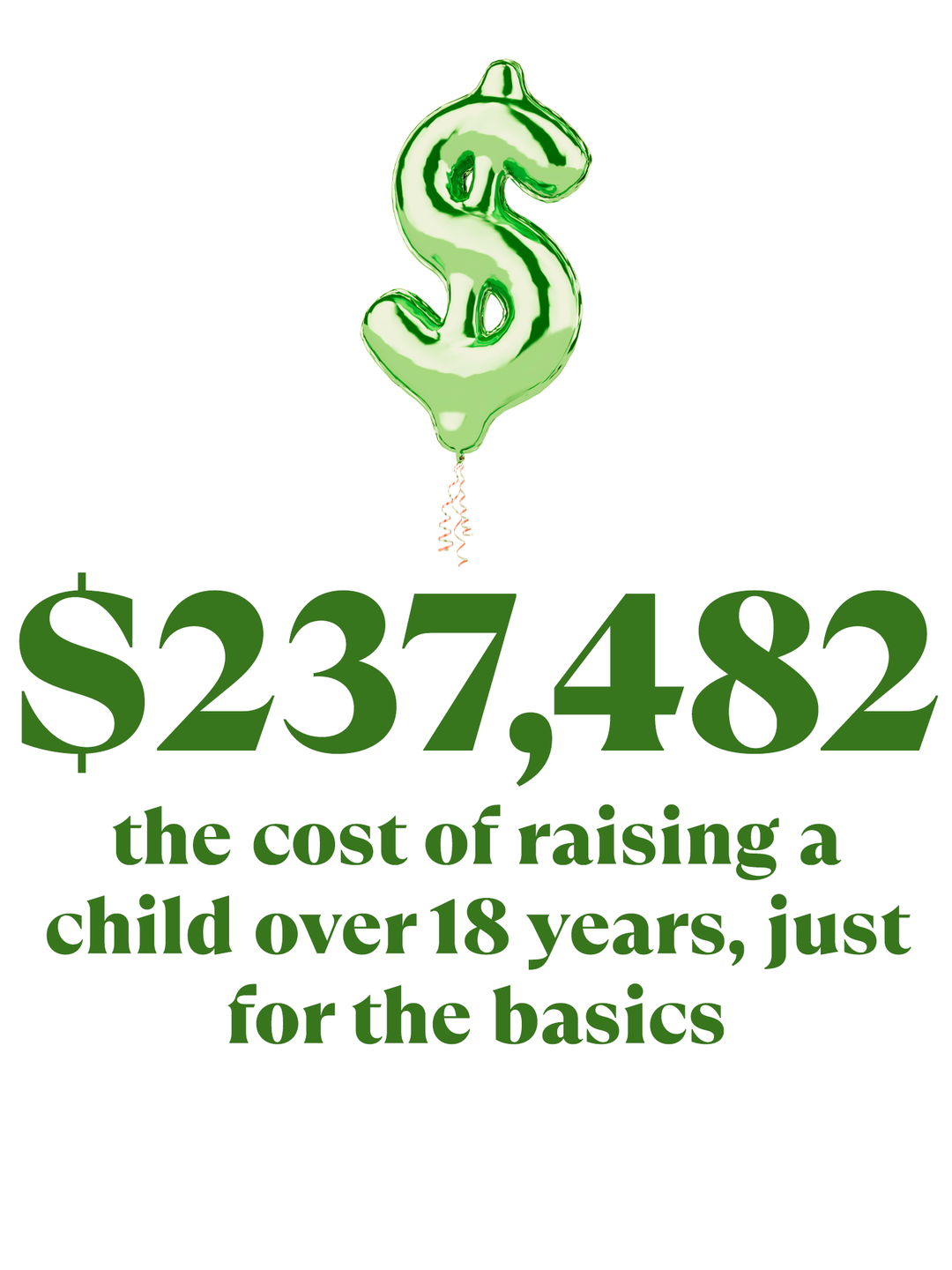Raising a Child in America Is Getting More Expensive at an Alarming Rate

Yes, the moment a squishy new baby enters the world, it becomes immediately apparent that they're worth every penny — and then some. But just how many pennies does it take?
Prepare yourself for the sticker shock: According to a 2023 study by LendingTree, the nationwide average for the cost of raising a child is $21,681 per year. The study took into account rent, food, child care, clothing, transportation, health insurance premiums and state tax exemptions or credits. It did not include the cost of college.
With these (and inflation) in mind, LendingTree estimates that the cost of raising a child over 18 years is $237,482, just for the basic necessities — the study doesn’t include the nice-to-haves like vacations, outings or enrichment classes, which can also take a big bite out of a family budget.
It’s not just that the cost of raising a child is high. It’s that it’s getting more expensive at an alarming rate. The same LendingTree study estimates a 19% jump in the cost of raising a kid just from 2016 and 2023.
Look back further, and the picture doesn’t get any rosier. The USDA also tabulates its own estimate of the cost of raising a child from birth to age 17. It uses many of the same expenses as LendingTree but also includes room for miscellaneous expenses, like toothpaste, haircuts and entertainment. For the most recent year available (2015, which doesn’t even account for how much more expensive everything has gotten post-pandemic), the total estimate for the cost of raising a child was $233,610. (Brookings says that, to account for higher inflation, that number could be even higher — closer to $310,605.) That represents a price tag of “between $12,350 and $13,900 for a child in a two-child, married-couple family in the middle-income group,” the USDA report says.

Twenty years earlier, in 1995, the USDA estimated cost for the same group was between $7,610 and $8,710. That represents a 38% increase. And yet, in the same period, middle-income parents’ hourly wages and purchasing power basically remained flat, according to Pew Research, which means that the costs of raising kids is taking up a bigger slice of the overall household budget.
So, why does it take so much?
Child care is so expensive.
The United States is a country with no federal paid parental leave and no universal (or even affordable) federal child care programs, the cost burden of child care falls squarely on parents’ shoulders. And, since federal funds that propped up the child care industry during the worst of the COVID-19 pandemic have expired — a crisis known as the going over the “child care cliff” — that cost is only going up.
"With child care costs climbing, parents are becoming adept at crafting their own unique 'child care recipe' — a blend of support from family and friends, shared arrangements like nanny shares or co-ops, and leveraging after-school programs, camps and employer subsidies,” says Lynn Perkins, CEO and co-founder, UrbanSitter. “This approach to the child care puzzle is a testament to the resourcefulness of families striving to balance quality care for their children with the financial realities of today, where childcare for two kids can consume up to 39% of a household's income."
According to UrbanSitter’s 2023 Working Parent & Child Care Report, more than half of parents (52%) spend $1,000 or more on child care per month, and nearly a quarter (24%) spend $2,000 or more.
According to a new, 2024 study by LendingTree, families who pay for child care spend on average nearly a fifth of their budget on it. This is an 18% increase since going over the child care cliff. "Unfortunately, the trend toward higher and higher child care costs is almost certain to continue, at least in the near future," says Matt Schulz, LendingTree's chief credit analyst. "While inflation isn't rising as fast as it was a year or two ago, it definitely isn't gone. That means that struggling families should expect to have to pay more for child care in the next few years than what they're paying now. That's bad news, considering just how tight so many Americans' household budgets are."
Parents also have to spend more on necessities.
According to the USDA’s most recent study, in addition to child care, the biggest child-raising expenses were housing and food. Housing represented 29% of a family’s budget, while food was 18%.
And again, the overall picture has changed in ways that make it more difficult for parents today. In 1995, according to the National Association of Realtors, the housing affordability index was 126.9 (where higher numbers equal more affordable houses) and the income needed to purchase a home was $64,192 in 2023 dollars. Today, the housing affordability index is just 94.2, the qualifying income to purchase a home is $105,504.
And food? Forget about it. “In 2022, food prices increased by 9.9 percent, faster than any year since 1979,” due to a combination of factors, from inflation to the conflict in Ukraine and an avian flu outbreak that affected poultry, the Economic Research Service of the U.S. Department of Agriculture reports. It says that the increases in food prices appear to be slowing, but we know from the bottom line at the grocery checkout that true relief has not come yet.

The first year of a baby’s life comes with unique expenses.
Cribs, car seats, diapers — babies require a lot of gear. A 2022 study conducted by BabyCenter revealed that common expenses just for the first year of a baby’s life now exceed $15,000, which represents 27% of a family’s annual income.
Of course, this isn’t just about the gear and equipment, which BabyCenter estimates is about $2,800 of that figure. It also includes the bigger expenses we mentioned above — the child care ($6,525 for the first year) and nutrition ($2,479). But BabyCenter also estimates the first-year cost of diapers at $1,104, which first-time parents may forget to add to the budget.
And while the cost of raising children seems like an individual problem, "This has potentially huge implications for our society going forward," Shulz says. "People are terrified of the costs of having children. This could lead to families having fewer kids or no kids at all. For those that do have kids, they simply may not be able to afford to go into the workforce when their kids are young. That means less expendable income for things like emergency funds, retirement savings, mortgage down payments, small business startups and even just fun things like vacations and concert tickets. All of this adds up to a potentially very big deal for the economy."

And while things now look particularly bleak, with no indication of relief in sight, there is reason for hope. "Tough economic times don't last forever," Shulz says. "Inflation eventually subsides. Good things begin to happen. That doesn't mean that anyone should expect child care costs will fall in coming years, but it does mean that the hockey-stick price growth we've seen in recent years won't always be the norm."
In the meantime, here are some things Shulz recommends for weathering the storm.
Seek out assistance from government organizations and other nonprofit groups. They might be able to help struggling parents manage child care costs. (Family and friends might be able to help if you're lucky, too.)
Adjust your budget to assume that prices are going to keep rising. "Better to plan ahead for the worst-case scenario and be pleasantly surprised than to hope for the best and be disappointed," Shulz says.
Work to reduce debts. If you see a kid in your future, freeing up the funds that go toward loan repayment can certainly help. Shulz recommends consolidating your debts with a 0% balance transfer credit card or a low-interest personal loan.
You Might Also Like
